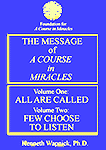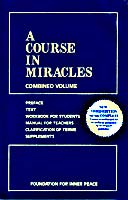

THE COURSE'S USE OF LANGUAGE-II
THE SYMBOLISM OF FORGIVENESS
Chapter 3, FEW CHOOSE TO LISTEN
from
Volume Two of THE
MESSAGE OF A COURSE IN MIRACLES®
By Kenneth Wapnick, Ph.D.
Introduction
The issue of Jesus correcting our mistakes at the level we can accept and understand has already been discussed, but we return to it now more specifically in this chapter to see how forgiveness serves as the great symbol of A Course in Miracles.As the correction for the ego's story of sin, guilt, and fear of punishment, forgiveness cannot be real (since it corrects what never happened) but is rather a symbol for what alone is real: the Love of God. However, as the Course teaches us, this correction does not oppose reality for it reflects the non-dualistic and non-oppositional truth. Forgiveness thus gently undoes the ego's voice, which allows the Son to hear the only Voice in this dualistic and symbolic world that can lead him beyond it to the truth of God's Love. Incidentally, it is this gentle process of correcting our errors through intermediate steps that makes A Course in Miracles unique in the history of non-dualistic spiritualities. It retains the integrity of a non-dualistic metaphysical system, yet allows its truth to be reflected into the dualistic world where the Son believes he lives. One wonderful example of this gentleness is seen in the following passage which discusses awakening from the ego's dream of terror. It is a nice entree to our discussion:
So fearful is the dream, so seeming real, he [the Son of God] could not waken to reality without the sweat of terror and a scream of mortal fear, unless a gentler dream preceded his awaking, and allowed his calmer mind to welcome, not to fear, the Voice that calls with love to waken him; a gentler dream, in which his suffering was healed and where his brother was his friend. God willed he waken gently and with joy, and gave him means to waken without fear (T-27.VII.13:4-5).
Forgiveness As a Dualistic Symbol Forgiveness, of course, is the means of awakening from the ego's dream of terror. And it is a means which, Jesus emphasizes, is illusory, as shown in the following passages:
Illusion makes illusion. Except one. Forgiveness is illusion that is answer to the rest.Forgiveness is thus the process of correcting the ego's symbols (belonging to the dualistic world), thereby undoing the ego thought system and making room for the non-dualistic truth to be recognized and accepted.Forgiveness sweeps all other dreams away, and though it is itself a dream, it breeds no others. All illusions save this one must multiply a thousandfold. But this is where illusions end. Forgiveness is the end of dreams, because it is a dream of waking. It is not itself the truth. Yet does it point to where the truth must be, and gives direction with the certainty of God Himself. It is a dream in which the Son of God awakens to his Self and to his Father, knowing They are one (W-pI.198.2:8-3:7; italics mine).
Forgiveness might be called a kind of happy fiction; a way in which the unknowing can bridge the gap between their perception and the truth. They cannot go directly from perception to knowledge because they do not think it is their will to do so. This makes God appear to be an enemy instead of what He really is. And it is just this insane perception that makes them unwilling merely to rise up and to return to Him in peace.
And so they need an illusion of help because they are helpless; a Thought of peace because they are in conflict (C-3.2:1-3:1; italics mine).
We turn to two passages from the workbook where Jesus makes it clear, again, that forgiveness itself is unreal and illusory, being simply a reflection of the non-dualistic Love of Heaven:
God not does forgive because He has never condemned.... Yet forgiveness is the means by which I [the student] will recognize my innocence. It is the reflection of God's Love on earth. It will bring me near enough to Heaven that the Love of God can reach down to me and raise me up to Him (W-pI.60.1:2, 4-6; italics mine).We examine now a brief passage that describes forgiveness' role in undoing the ego's illusions -- substituting a happy illusion for the ego's illusions of fear -- and clearing the way for the return of truth:For Love must give, and what is given in His Name takes on the form most useful in a world of form.
These are the forms which never can deceive, because they come from Formlessness Itself. Forgiveness is an earthly form of love, which as it is in Heaven has no form. Yet what is needed here is given here as it is needed. In this form you can fulfill your function even here, although what love will mean to you when formlessness has been restored to you is greater still (W-pI.186.13:5-14:4; italics mine).
Yet although God does not forgive, His Love is nevertheless the basis of forgiveness. Fear condemns and love forgives. Forgiveness thus undoes what fear has produced, returning the mind to the awareness of God. For this reason, forgiveness can truly be called salvation. It is the means by which illusions disappear (W-pI.46.2).Our final passage in this section on forgiveness provides yet another clear description of the dualistic nature of forgiveness, which is based upon the contrast of opposites, but which should not be confused with the non-dualistic reality that has no opposite. The reader may recall, incidentally, the earlier quoted passage from the obstacles to peace (T-19.IV-C.11:2-3) where Jesus emphasizes the importance of distinguishing between symbol and source, form and content.Unweakened power, with no opposite, is what creation is. For this there are no symbols. Nothing points beyond the truth, for what can stand for more than everything? Yet true undoing must be kind. And so the first replacement for your picture is another picture of another kind.And so forgiveness is a temporary correction -- a means to an end -- for the belief in the reality of the ego's insane thought system. It is a "kind (though illusory) undoing" of the ego's illusory "doing" of attack. To state this important point once again, understanding the important distinction between the truth of non-duality and the illusion of duality, emphasized again in this passage, is essential if one is truly to understand A Course in Miracles. Since, once again, forgiveness corrects what never was, it too must not truly be. Thus it is we speak of forgiveness as a symbol, and all the passages in the Course where Jesus speaks of forgiving your brother can be understood to be metaphors for the process of undoing the illusion that occurs only within the mind. We turn now to a discussion of this essential point.As nothingness cannot be pictured, so there is no symbol for totality. Reality is ultimately known without a form, unpictured and unseen. Forgiveness is not yet a power known as wholly free of limits. Yet it sets no limits you have chosen to impose. Forgiveness is the means by which the truth is represented temporarily. It lets the Holy Spirit make exchange of pictures possible, until the time when aids are meaningless and learning done. No learning aid has use that can extend beyond the goal or learning. When its aim has been accomplished it is functionless. Yet in the learning interval it has a use that now you fear, but yet will love....
Forgiveness vanishes and symbols fade, and nothing that the eyes have ever seen or ears have heard remains to be perceived. A Power wholly limitless has come, not to destroy, but to receive its own. There is no choice of function anywhere. The choice you fear to lose you never had. Yet only this appears to interfere with power unlimited and single thoughts, complete and happy, without opposite. You do not know the peace of power that opposes nothing. Yet no other kind can be at all. Give welcome to the power beyond forgiveness, and beyond the world of symbols and of limitations. He [God] would merely be, and so He merely is (T-27.III.4:4-5:9; 7; italics mine).
PART
EIGHT, - THE COURSE'S USE OF LANGUAGE ~II,
part
2 =>
<=RETURN
TO PAGE OF LINKS FOR KEN WAPNICK
Index Link Box For All parts of THE COURSE'S USE OF LANGUAGE
| I, part 1 | I, part 2 | I, part 3 | I, part 4 | I, part 5 | I, part 6 | II, part 1 | II, part 2 | II, part 3 | II, part 4 |
Miracle Studies Navigation Table